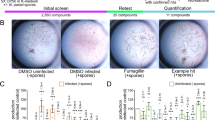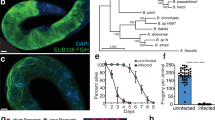Abstract
The growth of pathogens is dictated by their interactions with the host environment1. Obligate intracellular pathogens undergo several cellular decisions as they progress through their life cycles inside host cells2. We have studied this process for microsporidian species in the genus Nematocida as they grew and developed inside their co-evolved animal host, Caenorhabditis elegans3–5. We found that microsporidia can restructure multicellular host tissues into a single contiguous multinucleate cell. In particular, we found that all three Nematocida species we studied were able to spread across the cells of C. elegans tissues before forming spores, with two species causing syncytial formation in the intestine and one species causing syncytial formation in the muscle. We also found that the decision to switch from replication to differentiation in Nematocida parisii was altered by the density of infection, suggesting that environmental cues influence the dynamics of the pathogen life cycle. These findings show how microsporidia can maximize the use of host space for growth and that environmental cues in the host can regulate a developmental switch in the pathogen.
This is a preview of subscription content, access via your institution
Access options
Subscribe to this journal
Receive 12 digital issues and online access to articles
$119.00 per year
only $9.92 per issue
Buy this article
- Purchase on Springer Link
- Instant access to full article PDF
Prices may be subject to local taxes which are calculated during checkout




Similar content being viewed by others
References
Gog, J. R. et al. Seven challenges in modeling pathogen dynamics within-host and across scales. Epidemics 10, 45–48 (2015).
Casadevall, A. Evolution of intracellular pathogens. Annu. Rev. Microbiol. 62, 19–33 (2008).
Troemel, E. R., Felix, M. A., Whiteman, N. K., Barriere, A. & Ausubel, F. M. Microsporidia are natural intracellular parasites of the nematode Caenorhabditis elegans. PLoS Biol. 6, 2736–2752 (2008).
Cuomo, C. A. et al. Microsporidian genome analysis reveals evolutionary strategies for obligate intracellular growth. Genome Res. 22, 2478–2488 (2012).
Luallen, R. J. et al. Discovery of a natural microsporidian pathogen with a broad tissue tropism in Caenorhabditis elegans. PLoS Pathogens 12, e1005724 (2016).
Welch, M. D. & Way, M. Arp2/3-mediated actin-based motility: a tail of pathogen abuse. Cell Host Microbe 14, 242–255 (2013).
Ciechonska, M. & Duncan, R. Reovirus FAST proteins: virus-encoded cellular fusogens. Trends Microbiol. 22, 715–724 (2014).
French, C. T. et al. Dissection of the Burkholderia intracellular life cycle using a photothermal nanoblade. Proc. Natl Acad. Sci. USA 108, 12095–12100 (2011).
Nikitas, G. et al. Transcytosis of Listeria monocytogenes across the intestinal barrier upon specific targeting of goblet cell accessible E-cadherin. J. Exp. Med. 208, 2263–2277 (2011).
Swann, J., Jamshidi, N., Lewis, N. E. & Winzeler, E. A. Systems analysis of host–parasite interactions. Wiley Interdiscip. Rev. Syst. Biol. Med. 7, 381–400 (2015).
Stentiford, G. D. et al. Microsporidia—emergent pathogens in the global food chain. Trends Parasitol. 32, 336–348 (2016).
Cali, A. & Takvorian, P. M. in Microsporidia: Pathogens of Opportunity (eds Weiss, L. M. & Becnel, J. J. ) 71–133 (Wiley, 2014).
Felix, M. A. & Duveau, F. Population dynamics and habitat sharing of natural populations of Caenorhabditis elegans and C. briggsae. BMC Biol. 10, 59 (2012).
Bakowski, M. A. et al. Ubiquitin-mediated response to microsporidia and virus infection in C. elegans. PLoS Pathogens 10, e1004200 (2014).
Balla, K. M. & Troemel, E. R. Caenorhabditis elegans as a model for intracellular pathogen infection. Cell Microbiol. 15, 1313–1322 (2013).
Legouis, R. et al. LET-413 is a basolateral protein required for the assembly of adherens junctions in Caenorhabditis elegans. Nat. Cell Biol. 2, 415–422 (2000).
Sapir, A., Avinoam, O., Podbilewicz, B. & Chernomordik, L. V. Viral and developmental cell fusion mechanisms: conservation and divergence. Dev. Cell 14, 11–21 (2008).
Altun, Z. F. & Hall, D. H. Muscle System: Somatic Muscle (WormAtlas, 2009); http://www.wormatlas.org/hermaphrodite/musclesomatic/MusSomaticframeset.html
Altun, Z. F. & Hall, D. H. Epithelial System: Seam Cells (WormAtlas, 2009); http://www.wormatlas.org/hermaphrodite/seam%20cells/Seamframeset.html
Krishna, S., Maduzia, L. L. & Padgett, R. W. Specificity of TGFbeta signaling is conferred by distinct type I receptors and their associated SMAD proteins in Caenorhabditis elegans. Development 126, 251–260 (1999).
Maduzia, L. L. et al. lon-1 regulates Caenorhabditis elegans body size downstream of the dbl-1 TGF beta signaling pathway. Dev. Biol. 246, 418–428 (2002).
Estes, K. A., Szumowski, S. C. & Troemel, E. R. Non-lytic, actin-based exit of intracellular parasites from C. elegans intestinal cells. PLoS Pathogens 7, e1002227 (2011).
Szumowski, S. C., Botts, M. R., Popovich, J. J., Smelkinson, M. G. & Troemel, E. R. The small GTPase RAB-11 directs polarized exocytosis of the intracellular pathogen N. parisii for fecal–oral transmission from C. elegans. Proc. Natl Acad. Sci. USA 22, 8215–8220 (2014).
Leitch, G. J., Shaw, A. P., Colden-Stanfield, M., Scanlon, M. & Visvesvara, G. S. Multinucleate host cells induced by Vittaforma corneae (Microsporidia). Folia Parasitol. (Praha) 52, 103–110 (2005).
Morris, D. J., Terry, R. S. & Adams, A. Development and molecular characterisation of the microsporidian Schroedera airthreyi n. sp. in a freshwater bryozoan Plumatella sp. (Bryozoa: Phylactolaemata). J. Eukaryot. Microbiol. 52, 31–37 (2005).
Stentiford, G. D. et al. Areospora rohanae n.gen. n.sp. (Microsporidia; Areosporiidae n. fam.) elicits multi-nucleate giant-cell formation in southern king crab (Lithodes santolla). J. Invertebr. Pathol. 118, 1–11 (2014).
Lom, J. & Dykova, I. Microsporidian xenomas in fish seen in wider perspective. Folia Parasitol. (Praha) 52, 69–81 (2005).
Sprague, G. F. Jr & Winans, S. C. Eukaryotes learn how to count: quorum sensing by yeast. Genes Dev. 20, 1045–1049 (2006).
Olive, A. J. & Sassetti, C. M. Metabolic crosstalk between host and pathogen: sensing, adapting and competing. Nat. Rev. Microbiol. 14, 221–234 (2016).
Brenner, S. The genetics of Caenorhabditis elegans. Genetics 77, 71–94 (1974).
Stiernagle, T. Maintenance of C. elegans (WormBook, 2006); http://www.wormbook.org/chapters/www_strainmaintain/strainmaintain.html
Gurskaya, N. G. et al. Engineering of a monomeric green-to-red photoactivatable fluorescent protein induced by blue light. Nat. Biotechnol. 24, 461–465 (2006).
Schindelin, J. et al. Fiji: an open-source platform for biological-image analysis. Nat. Methods 9, 676–682 (2012).
Winston, W. M., Molodowitch, C. & Hunter, C. P. Systemic RNAi in C. elegans requires the putative transmembrane protein SID-1. Science 295, 2456–2459 (2002).
Hoch, H. C., Galvani, C. D., Szarowski, D. H. & Turner, J. N. Two new fluorescent dyes applicable for visualization of fungal cell walls. Mycologia 97, 580–588 (2005).
Acknowledgements
The authors thank M. Botts, K. Reddy and A. Reinke for comments on the manuscript. Some C. elegans strains were provided by the Caenorhabditis Genetics Center, which is funded by the National Institutes of Health (NIH) Office of Research Infrastructure Programs Grant P40 OD010440. This work was supported by National Science Foundation Graduate Research fellowships to K.M.B. and R.J.L., NIH grant no. R01GM114139, the David and Lucile Packard Foundation and a Burroughs Wellcome Fund fellowship to E.R.T.
Author information
Authors and Affiliations
Contributions
K.M.B., R.J.L. and E.R.T. designed the experiments. K.M.B. and R.J.L. performed the experiments and analysed the data. M.A.B. generated the ERT147 transgenic strain. R.J.L. and M.A.B. contributed to the manuscript. K.M.B. and E.R.T. wrote the manuscript.
Corresponding author
Ethics declarations
Competing interests
The authors declare no competing financial interests.
Supplementary information
Supplementary Information
Supplementary Video 1 Legend, Supplementary Table 1, Supplementary Figures 1–6 (PDF 723 kb)
Supplementary Video 1
Time lapse images of a live N. parisii-infected transgenic GFP::LET-413 animal (Same animal as shown in Figure 2b,c). (MOV 15614 kb)
Rights and permissions
About this article
Cite this article
Balla, K., Luallen, R., Bakowski, M. et al. Cell-to-cell spread of microsporidia causes Caenorhabditis elegans organs to form syncytia. Nat Microbiol 1, 16144 (2016). https://doi.org/10.1038/nmicrobiol.2016.144
Received:
Accepted:
Published:
DOI: https://doi.org/10.1038/nmicrobiol.2016.144
This article is cited by
-
Bacterial filamentation as a mechanism for cell-to-cell spread within an animal host
Nature Communications (2022)
-
Phosphatidic acid as a limiting host metabolite for the proliferation of the microsporidium Tubulinosema ratisbonensis in Drosophila flies
Nature Microbiology (2019)



